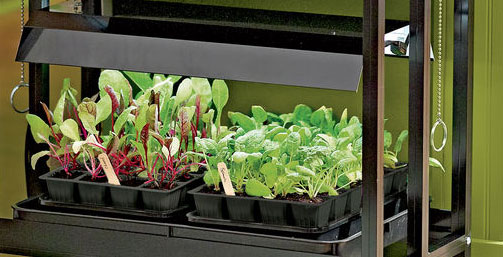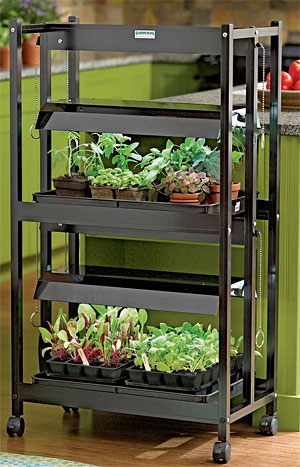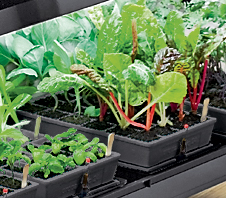






Grow lights are perfect for indoor seedstarting. You can also use them to grow light-loving houseplants, such as orchids.

Grow lights, such as this Compact 2-Tier SunLite Garden, are attractive enough to have in the kitchen. Our Vermont-made line of SunLite Gardens includes both standard (4 feet wide) and compact (2 feet wide) models.
WITH a set of grow lights, you can grow many plants indoors, including houseplants, orchids and some fruit and vegetable crops. Grow lights are ideal for seed starting because they help ensure stocky, green seedlings. A wintertime harvest of herbs and salad greens can also be grown under lights. By learning how plants use light and about the fixture options, you can select an indoor lighting system that is right for the plants you want to grow.
Sunlight contains the complete spectrum of light including all colors of the rainbow: red through yellow to blue and violet. Plants use the full spectrum for photosynthesis, although red and blue light seem to be most critical. Choose "full-spectrum" lights because they ensure that plants get the type of light they need.
The intensity of light that a plant receives is determined by the wattage of the bulb and by how close the plant is to the light source. Just as plants differ in their need for certain colors of light, they also differ in their need for light intensity. Typically, those plants that are native to tropical jungles or shady forests do not require as much light as plants that evolved in dry, sunny climates, such as the Mediterranean or southern Mexico.
Most flowering houseplants, such as African violets and begonias, are happy being 10 to 12 inches away from a light source. Foliage plants, such as ivy or philodendron, can be placed as much as 36 inches away from a light source. But many flowering plants, such as orchids, gardenias and citrus, as well as most vegetable plants, require a much higher light intensity to flower and produce fruit.
No matter what types of plants you are growing, you must give them a rest. When it's dark, plants respirate, which is an important part of their growth process. The balance of rest time to active growth time affects many biological processes, including the growth rate, and the setting of buds and fruit.

Vegetable seedlings need 14-18 hours of light a day.
Botanists usually divide plants into three categories relating to their preferred day length: short-day, long-day or day-neutral.
Short-day plants, such as chrysanthemums, kalanchoe, azaleas and begonias, will thrive on less than 12 hours of light per day. In fact, these plants must usually go through a series of even shorter days before they will set buds and flower.
Long-day plants require at least 14 to 18 hours of light each day. Most seedlings for vegetables and garden flowers are long-day plants. When they don't receive enough light they get pale and leggy.
Day-neutral plants, including foliage plants, geraniums, coleus and African violets, are usually satisfied with 8 to 12 hours of light all year-round.
Yes, but full-spectrum lights have more of the type of light plants need. Your plants will be healthier and more vigorous with abundant, full-spectrum light.
Fluorescents produce two to three times more light than incandescent bulbs for the same amount of energy. They are the most inexpensive lights for indoor gardening.
Full-spectrum fluorescent bulbs, such as our SunLite bulbs, produce a balance of cool and warm light that replicates the natural solar spectrum. These lights are excellent for seedlings as well as houseplants, culinary herbs and other plants. The bulbs in our Grow Light Stands are some of the best full-spectrum bulbs on the market, replicating 98 percent of the solar spectrum. The bulbs use less electricity and last significantly longer than standard fluorescent bulbs. If you're looking for complete grow kits, we invite you to check out the products at Green State Gardener, another great Vermont gardening company.
Copyright © www.100flowers.win Botanic Garden All Rights Reserved